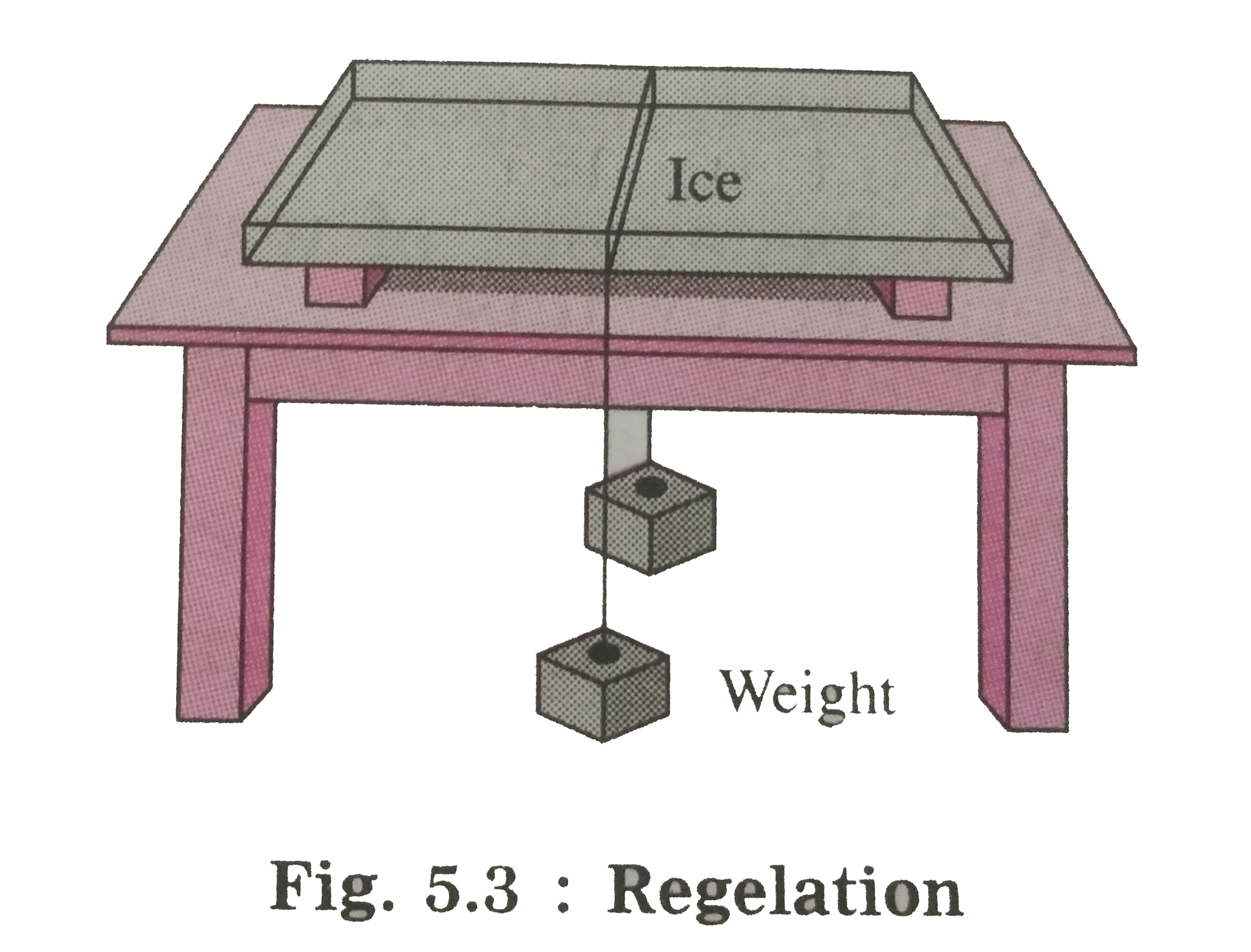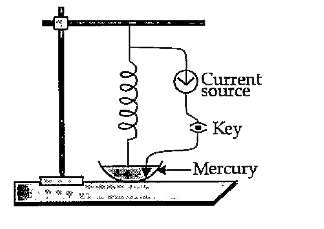Take some camphor or ammonium chloride.
Crush it and put in a china dish.
Put an inverted funnel over the china dish.
Put a cotton plug on the stem of the funnel, as shown in Fig.
Now, heat slowly and observe.

What do you infer from the above activity ?
(i) We will observe that camphor or ammonium chloride will directly change into vapour.
(ii) We infer that there are certain solids, which directly change into gaseous state without changing into the liquid state.
Topper's Solved these Questions
- MATTER IN OUR SURROUNDINGS BOOK - NAND LAL PUBLICATIONCHAPTER - MATTER IN OUR SURROUNDINGS EXERCISE - ACTIVITY 1.14
4 Videos
- MATTER IN OUR SURROUNDINGS BOOK - NAND LAL PUBLICATIONCHAPTER - MATTER IN OUR SURROUNDINGS EXERCISE - INTEXT QUESTIONS (PAGE 3)
4 Videos
- MATTER IN OUR SURROUNDINGS BOOK - NAND LAL PUBLICATIONCHAPTER - MATTER IN OUR SURROUNDINGS EXERCISE - ACTIVITY 1.12
1 Videos
- ATOMS AND MOLECULES BOOK - NAND LAL PUBLICATIONCHAPTER - ATOMS AND MOLECULES EXERCISE - ADDITIONAL QUESTIONS (LONG ANSWER TYPE QUESTIONS)
1 Videos
- STRUCTURE OF THE ATOM BOOK - NAND LAL PUBLICATIONCHAPTER - STRUCTURE OF THE ATOM EXERCISE - ADDITIONAL QUESTIONS (LONG ANSWER TYPE QUESTIONS )
1 Videos
Similar Questions
Using a pair of tongs, hold a piece of magnesium ribbon over a flame and heat it until the ribbon catches fire.Carefully, collect the white ash obtained from the burnt ribbon in a china dish. Dissolve a little bit of this ash in a test tube containing water. Read the following questions and try to answer them
(a). Test this solution with read and blue litmus papers. What do you observe?
(b). What can you conclude about the reaction of metals with oxygen from this experiment?
View SolutionTake a small slab of ice, a thin wire, two identical weights. Activity :
(1) Put a slab of ice on a stand as shown in figure.
(2) Hang two equal weights to the two ends of a metal wire and put the wire on the slab as shown in the figure.
What do you observe ?

View Solution
Knowledge Check
A student takes a mixture of sand and ammonium chloride in a china dish and heats it under a funnel fitted with a plug over a flame. He would observe that :
Asolid sand gets deposited on the lower cooler parts of the funnel while solid ammonium chloride remains in the china dishBsand and ammonium chloride get deposited on hotter parts of the funnelCammonium chloride gets deposited on the cooler parts of the funnel and sand remains in the china dish.Dsand collects on cooler parts of the funnel while ammonium chloride melts in the china dishThe steps involved in the separation of camphor and send from mixture are given below. Arrange them in a proper sequence.
(a) The wet cloth is put over the funnel and the stem is closed with cotton plug
(b) The mixture of camphor and sand is taken in the china dish and inverted funnel is kept on it.
(c ) the vapours are cooled and condensed to form the same solid and sand left behind in the dish
(d) The mixture is heated gently where the vapours of camphor is formedAbcdaBdabcCbadcDcdbacThe steps involved in the separation of camphor and sand from a mixture are given below. Arrange them in a proper sequence. (1) The wet cloth is placed over the funnel and the stem is closed with a cotton plug. (2) The mixture of camphor and sand is taken in the china dish and an inverted funnel is kept on it. (3) The vapours are cooled and condensed to form the same solid and sand left behind in the dish. (4) The mixture is heated gently where the vapours of camphor is formed.
A2,3,4,1B4,1,2,3C2,1,4,3D3,4,2,1
Take a small quantity of sulphur in a deflagrating spoon and heat it over the flame of a Bunsen burner. As soon as the sulphur catches fire, lower the spoon into a gas jar and close it with a lid. Wait until the sulphur stops burning.
Once the sulphur stops burning, take the spoon out of the jar. Now, pour a small amount of water into the jar and quickly close the lid again. Shake the jar well so that the gas formed in the jar dissolves in the water.
(a). Test this solution formed in the jar with red and blue litmus papers. What do you observe?
(b). What can you conclude about the reaction of non-metals with oxygen from this experiment?
View SolutionApparatus: Big test tube, delivery tube fitted in a rubber cork, knife, candle, etc.
Chemicals : Sodium metal, ethanol, magnesium ribbon, etc.
Procedure : Take 10 mL ethanol in a big test tube. Cut Sodium metal into 2-3 pieces of a cereal grain size. Put the sodium pieces into the ethanol in the test tube and fix the gas delivery tube to the test tube. Take a burning candle near the outlet of the gas delivery tube and observe.
Repeat the above procedure using magnesium ribbon instead of sodium. Do you see gas bubble released from the piece of magnesium ribbon?
View SolutionApparatus: Big test tube, delivery tube fitted in a rubber cork, knife, candle, etc.
Chemicals : Sodium metal, ethanol, magnesium ribbon, etc.
Procedure : Take 10 mL ethanol in a big test tube. Cut Sodium metal into 2-3 pieces of a cereal grain size. Put the sodium pieces into the ethanol in the test tube and fix the gas delivery tube to the test tube. Take a burning candle near the outlet of the gas delivery tube and observe.
Repeat the above procedure using magnesium ribbon instead of sodium. Do you see gas bubble released from the piece of magnesium ribbon?
View SolutionAttempt any 4 sub-parts out of 5. Each sub-part carries 1 mark.
Read the following text and answer the following questions on the basis of the same:
Roget's spiral:
Magnetic effects are generally smaller than electric effects. As a consequence, the force between currents is rather small, because of the smallness of the factor μ. Hence, it is difficult to demonstrate attraction or repulsion between currents. Thus, for 5 A current in each wire at a currents. Thus, for 5 A current in each wire at separation of 1 cm, the force per metre would be 5×10−4N, which is about 50 mg weight. It would be like pulling a wire by a string going over a pulley to which a 50 mg weight is attached. The displacement of the wire would be quite unnoticeable. With the use of a soft spring, we can increase the using mercury, we can make the displacement of even a few mm observable very dramatically. You will also need a constant-current supply giving a constant current of about 5 A. Take a soft spring whose natural period of oscillations is about 0.5-1s. Hang it vertically and attach a pointing tip to its lower end, as shown in the figure here. Take some mercury in a dish and adjust the spring such that the tip is just above the mercury surface. Take the DC current source, sonnect one of its terminals to the upper end of the spring and dip the other terminal in mercury. If the tip of the spring touches mercury, the circuit is completed through mercury. Let the DC source be put off to begin with. Let the tip be adjusted so that it just touches the mercury surface. Switch on the constant current supply and watch the fascinating outcome. The spring shrinks with a jerk, the tip comes out of mercury (just by a mm or so), the circuit is broken, the current stop, the spring relaxes and tries to comes back to its original position, the tip again touches mercury establishing a current in the circuit and the cycle continues with tick, tick, tick, ....
What else can be used instead of mercury in Roget's spiral?

View SolutionAttempt any 4 sub-parts out of 5. Each sub-part carries 1 mark.
Read the following text and answer the following questions on the basis of the same:
Roget's spiral:
Magnetic effects are generally smaller than electric effects. As a consequence, the force between currents is rather small, because of the smallness of the factor μ. Hence, it is difficult to demonstrate attraction or repulsion between currents. Thus, for 5 A current in each wire at a currents. Thus, for 5 A current in each wire at separation of 1 cm, the force per metre would be 5×10−4N, which is about 50 mg weight. It would be like pulling a wire by a string going over a pulley to which a 50 mg weight is attached. The displacement of the wire would be quite unnoticeable. With the use of a soft spring, we can increase the using mercury, we can make the displacement of even a few mm observable very dramatically. You will also need a constant-current supply giving a constant current of about 5 A. Take a soft spring whose natural period of oscillations is about 0.5-1s. Hang it vertically and attach a pointing tip to its lower end, as shown in the figure here. Take some mercury in a dish and adjust the spring such that the tip is just above the mercury surface. Take the DC current source, sonnect one of its terminals to the upper end of the spring and dip the other terminal in mercury. If the tip of the spring touches mercury, the circuit is completed through mercury. Let the DC source be put off to begin with. Let the tip be adjusted so that it just touches the mercury surface. Switch on the constant current supply and watch the fascinating outcome. The spring shrinks with a jerk, the tip comes out of mercury (just by a mm or so), the circuit is broken, the current stop, the spring relaxes and tries to comes back to its original position, the tip again touches mercury establishing a current in the circuit and the cycle continues with tick, tick, tick, ....
What are main 3 components in a Roget's spiral?

View Solution
